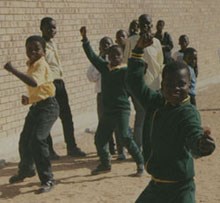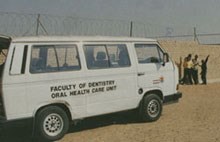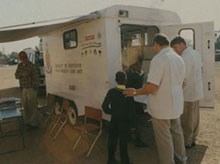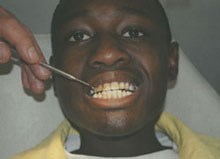South Africa - Hammanskraal Project
South Africa - Hammanskraal Project
Introduction
The presentation below is based on a fact-finding mission performed in August 2001.


children in the school
Background
In 1994 all the Universities in South Africa were asked to do a Reconstruction And Developing Program (RADP). The aim was to reach out to the people with different kinds of projects.
Dr J. Kroon, Department of Community Dentistry, was asked to start a project for the Faculty of Dentistry, University of Pretoria. Together with Colgate-Palmolive Foundation and the Gauteng Provincial Administration a mobile oral health care unit was presented.
The Mokonyama primary school in Hammanskraal was chosen and in May 1995 the project started.


mobile unit 
the team working with children
Project Outlines
The aim of the project was to expose dental and oral hygiene students to the principles of primary oral health care and to reach out to the children in the community.
Early in the morning the students from University of Pretoria and a supervisor go with the mobile unit to the school. The mobile unit is a trailer, with one dental chair. It is equipped with an autoclave, x-ray machine, suction and instrument to do restorative work and extractions. The dental team consists of two dental students, two oral hygiene students and a supervisor. When they arrive to the school, a sunshade is raised and attached to the van. Under this the dental hygienists prepare their chair. One assists and one work with the children. Inside, the two dental students prepare for the day's work.
In the beginning of the year all the children in the school are screened. It is determined if they need any dental care and what kind. All the children that need treatment are given a consent form to take home. The parents have to sign the consent form, which gives the dental students permission to work on the children. The consent forms are kept as a journal.
The treatment consists of cleaning, fissure sealant, bleaching, restorations and extractions, but the work that is performed is mostly fissure sealants and restorative work.
This particular area has a high fluoride concentration in the water; which gives a low incidence of caries but a lot of discolorations. This is why Professor Van Wyk, University of Pretoria started a bleaching program and about 50 children have been treated and with good results.
In this area people do not eat very much refined sugar. Together with the high fluoride concentration it has a good impact on the dental caries. That is perhaps why it is often sufficient with fissure sealant and oral hygiene instructions to keep the caries down.

Children being treated
Achievements
Until June 2000, 3237 children were screened of whom 2033 received treatment. 10175 dental procedures were performed.
198 extractions
7 453 fissure sealants
368 scaling and polishing
2 157 restorative treatments
In the end of this year Professor P J van Wyk, will evaluate the project. It has now been almost 6 years since it commenced.

in the treatment room
Constraints
When the Hammanskraal project started in 1995 the school had 600 children. Today the school has 1800 children, which makes it hard to treat all the children during one year. They try to treat the oldest children first and then work their way down in the classes.
The bleaching of the teeth is working well, but in the beginning the stains recurred. By using a sealer after bleaching the relapse is now less numerous. Due to the uneven surface of some of the teeth, there are stains that are impossible to remove.

fluorosis
Thanks to all people that helped me. Professor A.J. Ligthelm, Marie Odendaal, Dr Conrad Nel University of Pretoria, Faculty of dentistry.
Guest editor: Sanjay Haryana, a final year dental student from the University of Malmö, Faculty of Odontology, Sweden visited the University of Pretoria, South Africa, to participate in these projects in august 2001.
